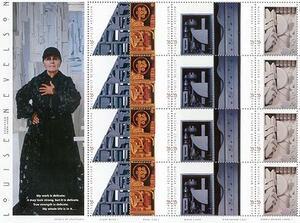Jewish Women Artists - Louise Nevelson
Louise Berliawsky was born on September 23, 1900, in Kiev, Ukraine. Her family immigrated to the United States when she was six years old and settled in Rockland, Maine. Her father was a timber merchant and, as a child, Louise played frequently in her father’s timber-yard. Louise’s childhood experiences in the forests of Maine may have predisposed her towards wood as a medium for sculpture later in life.
In 1920, Louise married Charles Nevelson, a wealthy ship owner, and moved to New York. Two years later, their son Myron Mike was born. In New York, Nevelson began to study visual and performing arts, including singing and dancing, and in 1928, she enrolled in New York’s Art Students’ League to study painting and sculpture. At this time, Nevelson was exposed to the artwork of Marcel Duchamp and Pablo Picasso.
In 1931, Nevelson and her husband separated. Nevelson left her son with her parents to travel through Europe. She studied ancient and modern art in Italy, Germany, and Paris and briefly attended Hans Hoffman’s school in Munich.
After her return to the United States in 1932, Nevelson joined a circle of well-known artists that included Diego Rivera and Ben Shahn. She assisted Rivera with murals he was executing under the WPA Federal Arts Project, including the monumental mural at Rockefeller Center in New York.
In the mid-thirties, Nevelson turned from drawing to sculpture and it was here that she found her true artistic identity. She began by nailing together pieces of wood and painting them in a uniform black tone. Nevelson later added white and gold coloring to her constructions.
Between 1933 and 1936, Nevelson’s work was included in a number of group exhibitions in New York. In 1936, she won the first prize for her wood sculptures at a competition at New York’s A.C.A. Gallery and, in 1937, she began to teach at the Educational Alliance School of Art on the Lower East Side, a WPA program. Nevelson’s first solo show was held in 1941 at the Nierendorf Gallery in New York.
During the 1950s, Nevelson became well known for her monumental box-shaped sculptures made out of fragments of wood, which she often found discarded on neighborhood streets. This original style received a great deal of acclaim and led Nevelson into circles of American surrealists, including Max Weber and Mark Rothko, with whom she later shared exhibitions.
In 1959, Nevelson’s all-white environment, “Dawn's Wedding Feast,” was exhibited in “Sixteen Americans,” a major group show at the Museum of Modern Art in New York. Nevelson’s piece consisted of one room, all in white, with bedding, a mirror, a wedding-cake, and a band.
Nevelson’s reputation grew throughout the 1960s and 70s. She was awarded a prize to represent the United States at the Venice Biennale in 1963 and had her first retrospective at New York’s Whitney Museum of American Art in 1967. Nevelson later received six honorary doctorates. As her fame increased, she became so preoccupied with her work that she neglected her relationship with her son. She regretted this later on.
When Nevelson was 60 years old, she started to weld discarded objects and steel into rigid geometrical forms. She painted these constructions black. She also created figures with Plexiglas, achieving “magic movements” through the use of light.
Nevelson’s work has been exhibited in the United States, Europe, Japan, and Canada. Her work is represented in the collections of most modern and contemporary art museums throughout the world and her sculptures can be seen in many public buildings and parks in the United States.
Louise Nevelson is known in the art world for her original painted wood sculptures, as well as for the integration of the Indian Folklore into the abstract art. She also initiated “The Four O’Clock Forum,” a series of gatherings of surrealist artists who discussed problems of American abstract expressionism. Cubistic mesh-like creations, constructivism, Hans Arp’s bas-reliefs, and Mexican and Indian motifs are all represented in her mural sculpture, “Moon garden Plus One.”
Louise Nevelson died in 1988 at the age eighty-nine. She is survived by her son Mike, who also became a successful sculptor. In recognition of Nevelson’s success, the U.S. government issued special Louise Nevelson commemorative stamps in 2000. There are five varieties of stamps, each with a photo of one of her monochrome sculptures. The City of New York also honored Nevelson by naming a plaza after her in downtown Manhattan.
Oral History Links
Museum and Gallery Links
- Guggenheim Museum—includes a biography of Louise Nevelson and link to works in the Guggenheim collection.
- The Whitney Museum of American—includes slides of eight Nevelson works that are in the Whiney Museum collection.
- Spaightwood Galleries—includes a brief biography of Louise Nevelson and photographs of five Nevelson works.
- Albright Knox Art Gallery—includes a photograph of Louise Nevelson’s Sky Cathedral, 1958, a biography of Nevelson, and suggestions for hands-on and discussion activities relating to her work.
Photographs of four large-scale sculptures by Nevelson
- Dawn Shadows in Chicago, Illinois
- Night Sail in Los Angeles, California
- Seventh Decade Forest in Baltimore, Maryland
- Transparent Horizon in Cambridge, Massachusetts



